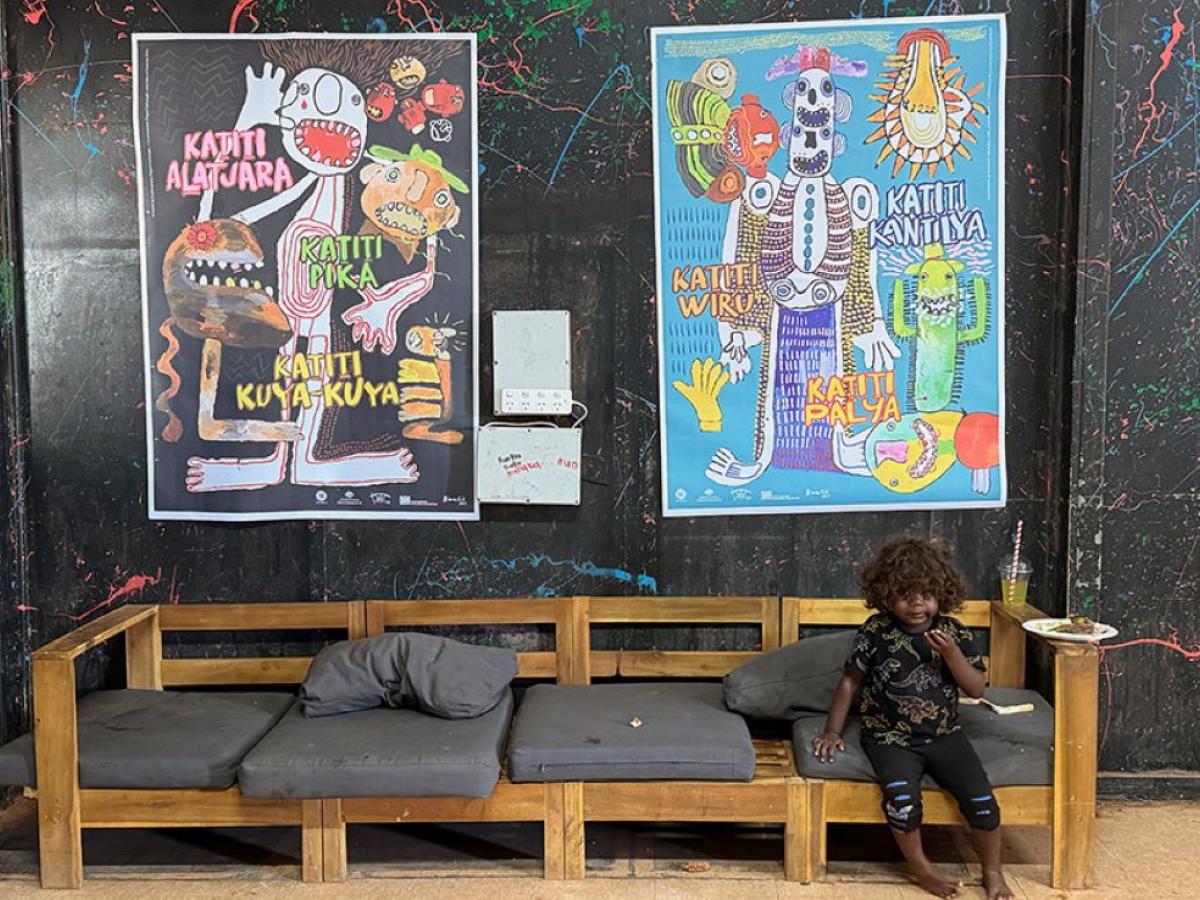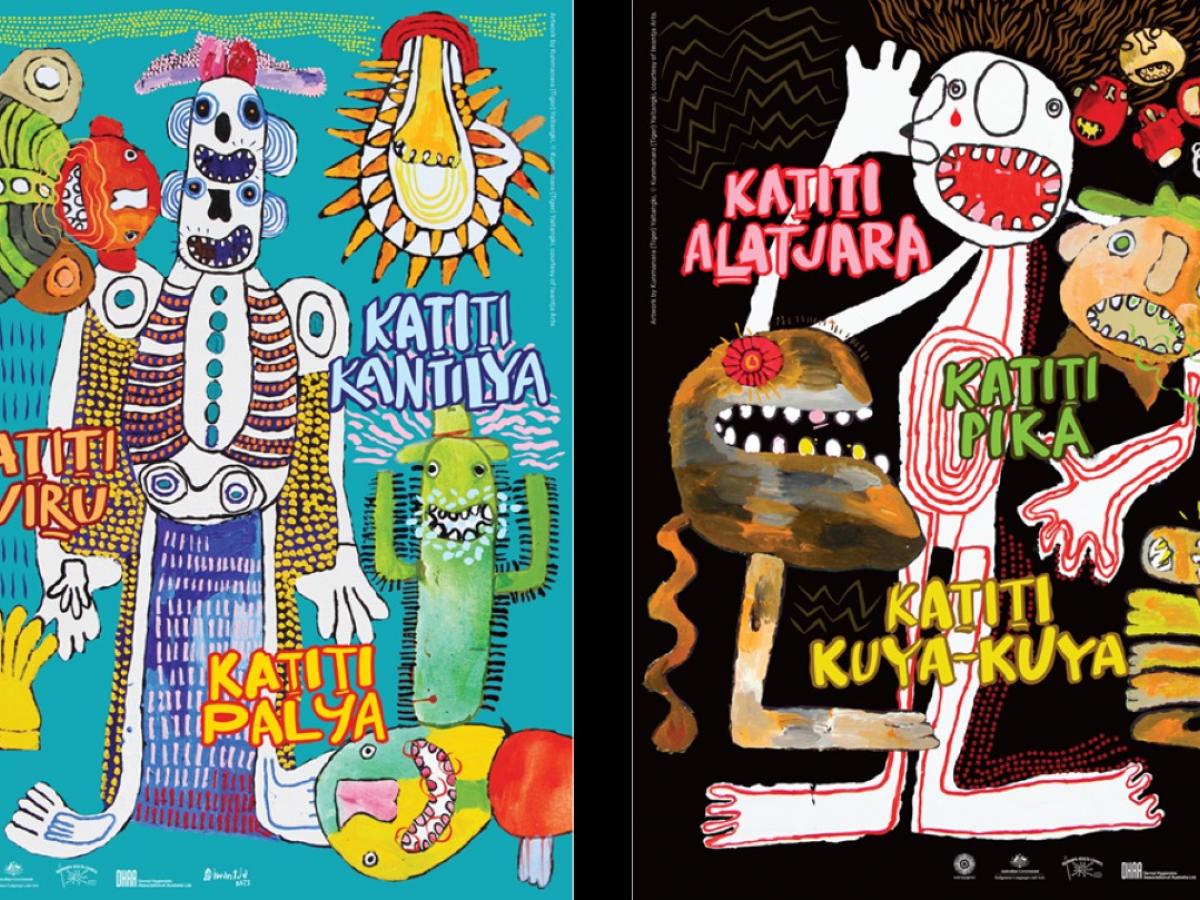New program targets oral health and language revival in APY Lands
A new art-driven pilot program by the University of Adelaide’s Mobile Language Team (MLT) is helping improve oral hygiene among Anangu (Aboriginal) children in remote communities while strengthening the Yankunytjatjara language on the APY Lands.

Launched in 2025, the ‘Closing the Gap through Oral Hygiene and Language in Remote Australia’ initiative focuses on Iwantja and Mimili Yankunytjatjara communities on the APY Lands, raising awareness about preventative dental care while preserving the Yankunytjatjara language.
The project — nicknamed Katiti Wiru, meaning Healthy Teeth in Yankunytjatjara — embeds oral health education into everyday life using local language and knowledge systems through community-based workshops and culturally relevant resources.
Artwork by renowned Iwantja artist, Kunmaṉara (Tiger) Yaltangki, features prominently in the campaign, appearing on posters, t-shirts, magnets and stickers, all delivering important messages in Yankunytjatjara. These materials encourage children to maintain strong, healthy teeth and warn of the dangers of holes, rot and decay.
In partnership with the Dental Hygienists Association of Australia and Nganampa Health Council, the project is led by Dr Paul Monaghan and fellow researchers Yankunytjatjara-Anangu woman Karina Lester, William Fisher and Emeritus Professor Peter Mühlhäusler, along with additional team members Uncle Trevor Buzzacott OAM, Amelia Amos and Phoebe Leggett.
“In recent years, there has been a focus on reducing the much higher rates of teeth and gum problems, dental disease, and oral-hygiene-related hospitalisation experienced by Anangu children in remote communities,” says Lester, MLT’s Aboriginal Co-Manager and Senior Aboriginal Language Expert.
“However, English is not the best medium for improving health outcomes in some remote Aboriginal communities. It can create additional barriers to understanding and engagement. This project seeks to improve the oral health of Anangu (Aboriginal) children by using an endangered Aboriginal language for talking about oral hygiene and follow-up health messaging. At the same time, it seeks to strengthen the Yankunytjatjara language by extending its use into new domains.”
Combining quantitative and qualitative research with linguistic theory, the project analyses the language surrounding oral hygiene practices to develop effective messaging.
“The project aims to close the gap by increasing oral health education that is accessible, and relevant for Aboriginal communities on the APY Lands," Dr Monaghan, MLT’s Manager and Senior Linguist says.
“By embedding oral health education in play and interactive learning, we aim to build positive language around oral hygiene, making it a familiar and enjoyable part of daily Yankunytjatjara life rather than something associated with outsiders, fear or obligation.
“Using the work of a local artist, who appeals to youth, to create messaging and the Yankunytjatjara language ensures that oral hygiene messages feel relevant, local and meaningful, rather than foreign and incomprehensible. Early feedback from communities indicates that this culturally grounded approach improves awareness of oral hygiene among children.”

Artwork by renowned Iwantja artist Kunmaṉara (Tiger) Yaltangki for MLT’s ‘Closing the Gap through Oral Hygiene and Language in Remote Australia’ program
The project is the culmination of two years of the MLT's 2022-2024 Oral Hygiene project which featured workshops, storytelling, games, and other learning activities in Yankunytjatjara, resulting in increased language use and research in new domains of language in Yankunytjatjara.
Dr Monaghan explains that Australia is the most dangerous continent for languages, with 90 percent of Aboriginal and Torres Strait Islander languages considered endangered or extinct. Less than half of the languages spoken before colonisation are still in use, and only six percent are “strong languages” spoken across all generations.
“The weakening or outright loss of Indigenous languages is more severe in Australia than any other continent,” he says. “The dominance of English has led to a dramatic reduction in the use of Indigenous languages. As traditional practices recede, so does the language associated with these practices.”
The Mobile Language Team is dedicated to the revival and maintenance of Aboriginal languages across South Australia and to promoting the use of Aboriginal languages to close the gap in health, education and employment for Aboriginal people. Since its establishment in 2009, MLT has successfully engaged with over 25 out of 47 South Australian Aboriginal languages.
Other MLT projects include training for Aboriginal people to support community-led language revival, support for early-childhood Indigenous language literacy, and a program to increase the number of Indigenous language educators working in regional and remote SA schools.
Dr Monaghan says the team hopes to apply the same methods of their oral hygiene program to other areas within health, wellbeing, education and criminal justice to benefit other remote communities where Indigenous languages are spoken daily.
“There is an urgent need for further targeted linguistic research into these domains, ensuring language remains central to community well-being and development,” he says.
Find out more about MLT on their website.
Note for journalists: Anangu is the term used for Pitjantjatjara Yankunytjatjara people of the APY Lands
Media contacts:
Karina Lester, Mobile Language Team Aboriginal Co-Manager and Senior Aboriginal Language Expert, The University of Adelaide. Email: karina.lester@adelaide.edu.au
Dr Paul Monaghan, Mobile Language Team Manager and Senior Linguist, The University of Adelaide. Email: paul.monaghan@adelaide.edu.au
Lara Pacillo, Media Officer, The University of Adelaide. Mobile: +61 404 307 302. Email: lara.pacillo@adelaide.edu.au
